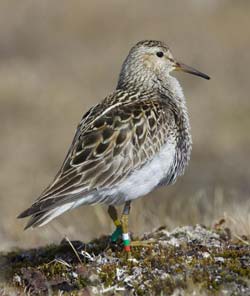You snooze, you lose

An attentive male sandpiper on the lookout for potential competitors. <br><br>© Wolfgang Forstmeier <br>
During the breeding season, polygynous male pectoral sandpipers that sleep the least sire the most young. A team of researchers headed by Bart Kempenaers from the Max Planck Institute for Ornithology in Seewiesen has now discovered this extraordinary relationship.
During three weeks of intense competition under the constant daylight of the Arctic summer, males actively court females and compete with other males. Using an innovative combination of tags that monitored movement, male-female interactions, and brain activity in conjunction with DNA paternity testing, the authors discovered that the most sleepless males were the most successful in producing young. As the first evidence for adaptive sleep loss, these results challenge the commonly held view that reduced performance is an evolutionarily inescapable outcome of sleep loss.
Sometimes it would be nice to have 24 hours available to finish the workload of the day. However, the drive for sleep inevitably compromises our performance or even causes us to fall asleep under dangerous situations, such as driving a car. Daily sleep is therefore thought to be essential for regenerating the brain and maintaining performance. This holds true both for humans and other animals. Researchers led by Bart Kempenaers from the Max Planck Institute for Ornithology in Seewiesen have now found that during the three-week mating period male pectoral sandpipers (Calidris melanotos) are active for up to 95% of the time. This is even more remarkable considering the fact that the birds have just arrived in their breeding area in Alaska, after migrating from their overwintering grounds in the southern hemisphere.
Pectoral sandpipers have a polygynous mating system where one male mates with several females. Because males do not engage in parental care, a male's reproductive success is determined exclusively by his access to fertile females. However, gaining this access is not that easy for pectoral sandpipers: “Males have to constantly repel their rivals through male-male competition and simultaneously convince females with intensive courtship display”, says director Bart Kempenaers. Given that the sun never sets during the Arctic summer, males that can engage in this extreme competition 24/7 should be at an advantage.
Indeed, the researchers found that the most active males interacted most with females and sired the most offspring. Paternity was determined by collecting DNA from all males, all females, and all offspring in the study area. To measure activity patterns, the researchers attached transmitters to the feathers of all males and most of the females. These radiotelemetry based senders allowed the team to monitor whether the animal was moving or resting. Finally, recordings of brain and muscle activity confirmed that active birds were awake and that inactive birds were in fact sleeping.
The brain activity recordings also reveal variation in sleep intensity: “Males that slept the least had the deepest sleep”, says co-author Niels Rattenborg who conducts sleep research at Seewiesen. Although this suggests that the birds might compensate for sleep loss by sleeping deeper, the researchers found that even when this was taken into consideration, the birds were still experiencing a deficit in sleep.
Based on the team’s data on birds that returned to the study area across breeding seasons, this reproductive sleep loss apparently has no long-term adverse impact on survival. On the contrary, successful males returned to the breeding area more often when compared to males siring less offspring and were more likely to sire offspring in their second year. Does the study question the dominant view that the function of sleep is to regenerate the brain? The researchers do not wish to go that far, although the findings clearly show that under certain circumstances animals may be able to evolve the ability to forgo, or postpone, large amounts of sleep while maintaining high neurobehavioral performance. Importantly, the finding that not every male does this, even when there are fertile females around, suggests that “Long sleeping males may lack genetic traits that enable short sleeping individuals to maintain high performance despite a lack of sleep”, argues Bart Kempenaers. The researchers believe that determining why only some males engage in this adaptive sleeplessness may provide insight into the evolution of this extreme behaviour, as well as the ongoing debate over the functions of sleep and its relationship to health and longevity in humans.
Contact
Prof. Dr. Bart Kempenaers
Max Planck Institute for Ornithology
Phone: +49 8157 932-334
Fax: +49 8157 932-400
Email: b.kempenaers@orn.mpg.de
Dr. Niels Rattenborg
Max Planck Institute for Ornithology
Phone: +49 8157 932-279
Email: rattenborg@orn.mpg.de
Original publication
John A. Lesku, Niels C Rattenborg, Mihai Valcu, Alexei L. Vyssotski, Sylvia Kuhn, Franz Kuemmeth, Wolfgang Heidrich, Bart Kempenaers
Adaptive Sleep Loss in Polygynous Pectoral Sandpipers
Science, advance online publication August 9, 2012
Media Contact
More Information:
http://www.mpg.de/5976385/sleeplessness_sandpipersAll latest news from the category: Life Sciences and Chemistry
Articles and reports from the Life Sciences and chemistry area deal with applied and basic research into modern biology, chemistry and human medicine.
Valuable information can be found on a range of life sciences fields including bacteriology, biochemistry, bionics, bioinformatics, biophysics, biotechnology, genetics, geobotany, human biology, marine biology, microbiology, molecular biology, cellular biology, zoology, bioinorganic chemistry, microchemistry and environmental chemistry.
Newest articles

Innovative 3D printed scaffolds offer new hope for bone healing
Researchers at the Institute for Bioengineering of Catalonia have developed novel 3D printed PLA-CaP scaffolds that promote blood vessel formation, ensuring better healing and regeneration of bone tissue. Bone is…

The surprising role of gut infection in Alzheimer’s disease
ASU- and Banner Alzheimer’s Institute-led study implicates link between a common virus and the disease, which travels from the gut to the brain and may be a target for antiviral…

Molecular gardening: New enzymes discovered for protein modification pruning
How deubiquitinases USP53 and USP54 cleave long polyubiquitin chains and how the former is linked to liver disease in children. Deubiquitinases (DUBs) are enzymes used by cells to trim protein…



